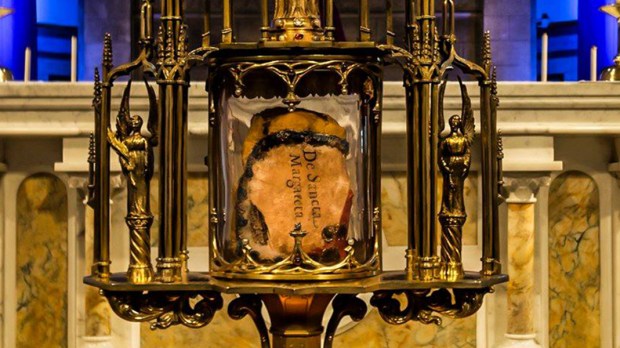In order to learn more about the life and history of one of the most revered saints of Scotland, a team of archaeologists have removed St. Margaret’s shoulder bone from its reliquary in the Dunfermline church that bears the saints name. The study will to utilize 3D scanning to learn more of the 11th-century Queen of Scotland’s lifestyle.
The team, led by Lauren Gill from the University of Glasgow and Martin Lane from Cardiff Metropolitan University, also intends to create a 3D model of the relic, so that it can be handled and examined without risking damage to the real relic. Gill reportedly sought permission from Archbishop Leo Cushley to begin the process. Gill told the Scotsman:
“Now that relics are less popular it is important that we understand why they hold an importance to the church and to worshipers. She was a great figure for Scotland and it is of national interest to find out more about her.”
The team says that the shoulder bone could tell if St. Margaret had a disease, like gout or osteo-arthritis, and could also show if she maintained proper nutrition. It is expected that the remains will exhibit malnutrition, as St. Margaret was known to fast for long periods of time. “You can tell already she was very small, and that is normal for a woman of her era,” Gill commented after first observing the relic.
St. Margaret, affectionately called “The Pearl of Scotland,” was renowned for her piety and devotion to the poor. She is largely responsible for introducing many refinements to the Scottish people, including the use of dinner utensils. During her life she also saw the construction of a ferry that helped pilgrims get to St. Andrews across the Firth of Forth from South to North Queensferry. The ferry carried her body back to Dunfermline after her death in 1093.
After Pope Innocent IV canonized her in 1250, St. Margaret’s remains were interred in a shrine built at Dunfermline. Her remains were undisturbed until the 16th century, when Mary, Queen of Scots, asked for St. Margaret’s head to be present for the birth of her son James VI.
Her head was eventually moved to a Jesuit College in Douai, France, where it stayed until it unfortunately disappeared during the French Revolution. To this day, the whereabouts of St. Margaret’s head are unknown.
During the Reformation, which threatened the destruction of many Catholic churches and abbeys, St. Margaret’s remains were moved to Madrid’s Escorial Monastery in secret by Philip II of Spain.
Her remains did not return to Scotland until the 19th century, when Bishop James Gillis of Edinburgh sought permission from Pope Pious IX.

